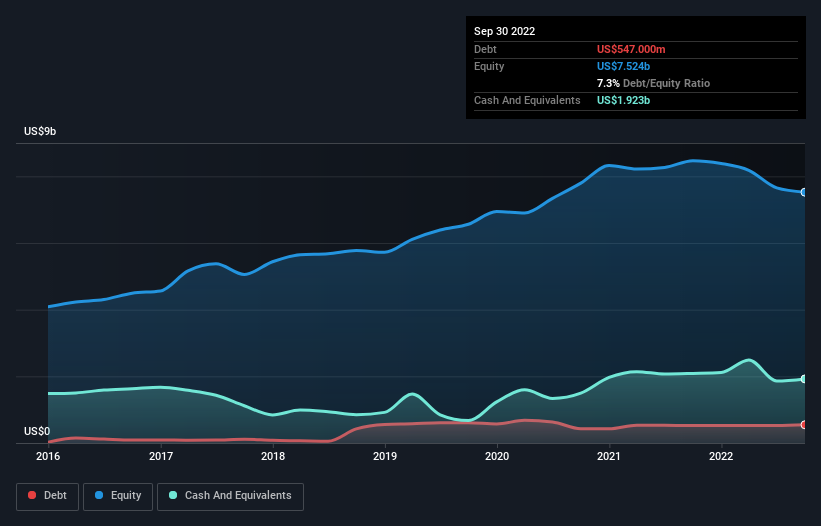
Some say volatility, rather than debt, is the best way to think about risk as an investor, but Warren Buffett famously said that 'Volatility is far from synonymous with risk.' When we think about how risky a company is, we always like to look at its use of debt, since debt overload can lead to ruin. We note that HCL Technologies Limited (NSE:HCLTECH) does have debt on its balance sheet. But the more important question is: how much risk is that debt creating?
When Is Debt Dangerous?
Debt and other liabilities become risky for a business when it cannot easily fulfill those obligations, either with free cash flow or by raising capital at an attractive price. If things get really bad, the lenders can take control of the business. However, a more common (but still painful) scenario is that it has to raise new equity capital at a low price, thus permanently diluting shareholders. Of course, debt can be an important tool in businesses, particularly capital heavy businesses. The first thing to do when considering how much debt a business uses is to look at its cash and debt together.
See our latest analysis for HCL Technologies
What Is HCL Technologies's Net Debt?
You can click the graphic below for the historical numbers, but it shows that as of September 2022 HCL Technologies had US$547.0m of debt, an increase on US$525.4m, over one year. However, it does have US$1.92b in cash offsetting this, leading to net cash of US$1.38b.

A Look At HCL Technologies' Liabilities
The latest balance sheet data shows that HCL Technologies had liabilities of US$2.30b due within a year, and liabilities of US$1.05b falling due after that. On the other hand, it had cash of US$1.92b and US$3.18b worth of receivables due within a year. So it actually has US$1.76b more liquid assets than total liabilities.
This surplus suggests that HCL Technologies has a conservative balance sheet, and could probably eliminate its debt without much difficulty. Simply put, the fact that HCL Technologies has more cash than debt is arguably a good indication that it can manage its debt safely.
The good news is that HCL Technologies has increased its EBIT by 2.1% over twelve months, which should ease any concerns about debt repayment. The balance sheet is clearly the area to focus on when you are analysing debt. But it is future earnings, more than anything, that will determine HCL Technologies's ability to maintain a healthy balance sheet going forward. So if you're focused on the future you can check out this free report showing analyst profit forecasts.
Finally, a business needs free cash flow to pay off debt; accounting profits just don't cut it. HCL Technologies may have net cash on the balance sheet, but it is still interesting to look at how well the business converts its earnings before interest and tax (EBIT) to free cash flow, because that will influence both its need for, and its capacity to manage debt. Over the last three years, HCL Technologies recorded free cash flow worth a fulsome 97% of its EBIT, which is stronger than we'd usually expect. That puts it in a very strong position to pay down debt.
Summing Up
While it is always sensible to investigate a company's debt, in this case HCL Technologies has US$1.38b in net cash and a decent-looking balance sheet. The cherry on top was that in converted 97% of that EBIT to free cash flow, bringing in US$1.8b. So we don't think HCL Technologies's use of debt is risky. When analysing debt levels, the balance sheet is the obvious place to start. But ultimately, every company can contain risks that exist outside of the balance sheet. We've identified 1 warning sign with HCL Technologies , and understanding them should be part of your investment process.
If, after all that, you're more interested in a fast growing company with a rock-solid balance sheet, then check out our list of net cash growth stocks without delay.
Valuation is complex, but we're here to simplify it.
Discover if HCL Technologies might be undervalued or overvalued with our detailed analysis, featuring fair value estimates, potential risks, dividends, insider trades, and its financial condition.
Access Free AnalysisHave feedback on this article? Concerned about the content? Get in touch with us directly. Alternatively, email editorial-team (at) simplywallst.com.
This article by Simply Wall St is general in nature. We provide commentary based on historical data and analyst forecasts only using an unbiased methodology and our articles are not intended to be financial advice. It does not constitute a recommendation to buy or sell any stock, and does not take account of your objectives, or your financial situation. We aim to bring you long-term focused analysis driven by fundamental data. Note that our analysis may not factor in the latest price-sensitive company announcements or qualitative material. Simply Wall St has no position in any stocks mentioned.
About NSEI:HCLTECH
HCL Technologies
Offers software development, business process outsourcing, and infrastructure management services worldwide.
Flawless balance sheet with solid track record and pays a dividend.


